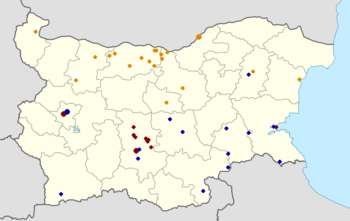Roman Catholic Church in Bulgaria
| Roman Catholic parishes in Bulgaria (as of 2007) | |

|
|
| Diocese of Sofia and Plovdiv | |
| Diocese of Nikopol | |
| Apostolic Exarchate Sofia | |

The Roman Catholic Church in Bulgaria is a diaspora church .
history
The Christianization of today's Bulgaria took place no later than the 4th century. An archbishop of Serdika (now Sofia) is attested at the Council of Nicaea . During the Great Migration , Christianity was pushed back and only persisted in a few communities. In the 8th and 9th centuries the re- Christianization took place , mainly from Byzantium, but also by missionaries from the western church such as the Fulda monk Gottschalk or Formosus from Porto. In 865 Tsar Boris I was baptized by Byzantine missionaries. At a time of serious disputes with the Eastern Church, in questions of canon law and in the Filioque dispute, Rome tried to extend its primacy to the Bulgarian Church. At the fourth Council of Constantinople in 870, the Byzantine bishops, in protest of the Roman delegates, decided to subordinate the Bulgarian church to Byzantium. Although Rome tried repeatedly in the following centuries to extend its primacy to Bulgaria, the Bulgarian Church, which received a patriarch in 976, remained under Byzantine influence.
Of importance for the history of the Western Church was the fact that in the 12th century crusaders and merchants came into contact with the Bogomils who had settled in Bulgaria and brought their ideas to the West, which led to the emergence of the Cathar movement.
In the meantime Bulgaria had come under Byzantine rule politically. After numerous uprisings, the Bulgarians succeeded in 1185/1186 in establishing a new empire that had its center in Tarnowo. Tsar Kalojan turned to Pope Innocent III in 1202 . with the request to crown him emperor and to recognize the independence of the Bulgarian church. In 1203 the Pope sent his legate Leone Brancaleo with the power to perform the coronation as king and to confer the title of Primate of Bulgaria and Wallachia on Archbishop Basilios of Tarnowo . At the same time an army of crusaders conquered Byzantium and installed a Latin emperor . After negotiations with the Latins failed, Bulgaria allied itself with the Nicene emperor in exile . As a result, the ecclesiastical union between Rome and Bulgaria lost its importance and became obsolete with the recognition of the Bulgarian patriarchate by the Greek patriarch in 1235 on the occasion of the wedding of the Byzantine prince Theodor Laskaris and Helenes, daughter of John II of Bulgaria.
In 1688 the Chiprowzi uprising, organized by Bulgarian Catholics, broke out against Ottoman rule .
In the 19th century, parts of the Bulgarian Orthodoxy came to a union with Rome when Josif Sokolski was ordained bishop of the Uniate Bulgarian Catholic Church in 1861 .
present
Around 65,000 Latin Catholics live in Bulgaria today in the two immediate dioceses of Sofia and Plovdiv and Nikopol , as do 10,000 Byzantine Catholics from the Eparchy of St. John XXIII. in Sofia the Bulgarian Catholic Church. This is not quite 1% of the country's approx. 8 million inhabitants, most of whom belong to the Bulgarian Orthodox Church . The Catholics who celebrate according to the Byzantine rite are subordinate to the Apostolic Exarchate of Sofia and are also referred to as believers of the Bulgarian Catholic Church .
Since 1991 the Holy See has sent an Apostolic Nuncio to Bulgaria. In 2002 the Holy See established the Bulgarian Bishops' Conference to which both the Latin rite dioceses ( Sofia and Plovdiv , Nikopol ) and the Apostolic Exarchate Sofia belong.
In 2002 Pope John Paul II visited Bulgaria.
List of dioceses
- Roman Catholic Church
- Bulgarian Catholic Church
See also
- Bulgarian Bishops' Conference
- List of Roman Catholic Dioceses
- Roman Catholic sacred buildings in Bulgaria
Individual evidence
- ↑ Hubert Jedin (Ed.): Handbuch der Kirchengeschichte , Vol. III / 1, Freiburg 1966, pp. 170–207.
- ↑ Ivan Dujčev: Bulgaria. IV. Religious and Church History . In: Lexicon of the Middle Ages (LexMA). Volume 2, Artemis & Winkler, Munich / Zurich 1983, ISBN 3-7608-8902-6 , Sp. 925-928.
- ↑ Hubert Jedin (Ed.): Handbuch der Kirchengeschichte , Vol. III / 1, Freiburg 1966, p. 207.
- ↑ Hubert Jedin (Ed.): Handbuch der Kirchengeschichte , Vol. III / 2, Freiburg 1968, p. 126.
- ↑ Aurelio of Santos-Otero: Bulgaria I . In: Theologische Realenzyklopädie (TRE). Volume 7, de Gruyter, Berlin / New York 1981, ISBN 3-11-008192-X , pp. 367-368.
- ^ History of the Bulgarian Catholic Church (English) ( Memento from December 5, 2013 in the Internet Archive )
literature
- Ivan Sofranov: Histoire du mouvement bulgare vers l'église catholique au XIX siècle. Première période: les origines 1855–1865. Desclée, Rome a. a. 1960.
- Charles A. Frazee: Catholics and Sultans. The church and the Ottoman Empire 1453-1923. Cambridge University Press, London 1983, ISBN 0-521-24676-8 , pp. 242-247.
- Daniela Kalkandjieva: The Catholic Church in Bulgaria and the Cold War. In: Gilbert Meynier, Maurizio Russo (eds.): L'Europe et la Méditerranée. Stratégies et itinéraires politiques et culturels en Méditerranée France et Italie, XIXe - XXe siècles, une approche comparative. L'Harmattan, Paris 1999, ISBN 2-7384-7630-9 , pp. 229-241.
Web links
- Catholic Church in Bulgaria
- History of the Catholic Church in Bulgaria , online edition of the Catholic Encyclopedia , Vol. 3, New York 1908 (English)
